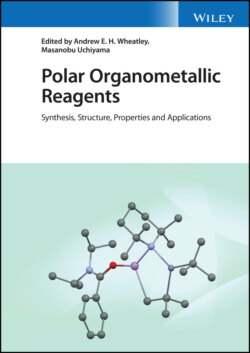Читать книгу Polar Organometallic Reagents - Группа авторов - Страница 26
1.4.6 Argentates
ОглавлениеTo bring the current narrative right up to date, the similarities between copper and silver, vertically related in the periodic table, have led to a recent interest in lithium argentates. However, whereas applications of organocopper compounds have proved extensive [231–233], those of their silver congeners have been much more limited due to the difficulties posed by their preparation. Hence, the Ag(0 → I) redox potential [234] of 0.8 V means that, unlike organocopper(I) compounds, organosilver(I) species cannot be made by oxidatively metalating organic halides [235]. Meanwhile, neither hydro (or carbo)‐argentation nor halogen–silver exchange have become well established, though isolated examples of borylargentation [236], fluoroargentation [237], and carboargentation [238] have been described. Meanwhile, transmetalation has been limited by the high reactivity of e.g. s‐block organometallics towards silver salts [239–241]. This has led to efforts to expand the field of DoM [242] to encompass silver chemistry. To engender development, the argentate analogue of Lipshutz cuprate 159 [213], (TMP)2Ag(CN)Li2(THF) 179, was prepared using AgCN and found to form a comparable, isolable dimer (Figure 1.31). At the same time, variation of the amido component was probed, with (HMDS)2Ag(CN)Li2(THF) (180, HMDS = hexamethyldisilamide), (DA)2Ag(CN)Li2(THF) 181, and (Cy2N)2Ag(CN)Li2(THF) (182, Cy = cyclohexyl) all being formed but only 179 and 182 proving effective in proof‐of‐concept iodinations of N,N‐diisopropylbenzamide. Thereafter, 179 was deployed in a range of directed ortho‐deprotometalations using various DMG and ancillary functional group (FG) permutations (Scheme 1.36). Work demonstrated the ability to use tertiary carboxylic amide DMGs of variable lability (yielding 183–185). The success of nitrile (giving 186) and methyl ester (giving 187) DMGs was remarkable given their incompatibility with e.g. organolithiums. Likewise, in contrast to the difficulty of metalating nitroarenes using traditional strong bases [243], and the fact that this has hitherto been achievable using only specific substrates [244], 188 and 189 were now smoothly generated by 179. Notably, the yield of 188 (80%) contrasted with just 6% obtained when using 159. Elsewhere (forming 190–192), ancillary styrene‐type FGs could be employed without detectable polymerization, while halides and pseudohalides were tolerated, enabling the demonstration that OTf [(trifluoromethanesulfonyl)oxy] could survive a deprotonative metalation sequence [245].
Figure 1.31 The dimer of lithium argentate (TMP)2Ag(CN)Li2(THF) 179.
Scheme 1.36 Examples of directed deprotometalation using lithium argentate 179. a Argentation at −40 °C. b ortho : meta >29 : 1. c ortho : meta >16 : 1 (Tf = trifluoromethanesulfonyl).
The compatibility of traditionally problematic DMGs with 179 suggested the formation of ortho‐argentate intermediates. This was further hinted at by the isolation of aryl argentates such as the crystalline dimer of [2‐(i‐Pr)2NC(O)‐C6H4]2AgLi(THF) 193 (Figure 1.32), the preliminary characterization of which points to further avenues of investigation in this area.
Having established the accessibility of a range of ortho‐iodides, the replacement of I2 with various disulfides was explored. Again, the use of 179 overcame the yield variability and limited FG compatibility encountered when attempting sulfide installation by treating established aryllithium [246, 247], or ‐magnesium [248] reagents with disulfides. Moreover, this could be combined with the DMG tolerance of 179 in preparing sulfides such as 194 (Scheme 1.37, top). Lastly, the oxidative inertness of silver meant that, unlike the corresponding cuprate, 179 avoided biaryl production when preparing azo compounds from diazonium salts [forming e.g. 195 in good yield (cf. 23% using 159), Scheme 1.37, bottom]. This reactivity overcame the S N Ar or SET processes typically seen when arylmetals react with diazoniums [249] whilst achieving uniquely heterocoupled products [250].
Figure 1.32 Molecular structure of the dimer of [2‐(i‐Pr)2NC(O)‐C6H4]2AgLi(THF) 193.
Source: Adapted from Tezuka et al. [245].
Scheme 1.37 Lithium argentate 179 shows good functional group tolerance when making sulfides while the oxidative inertness of silver avoids biaryl production when making azo compounds.
